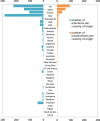SARS-CoV-2 introductions and early dynamics of the epidemic in Portugal
- PMID: 35603268
- PMCID: PMC9053228
- DOI: 10.1038/s43856-022-00072-0
SARS-CoV-2 introductions and early dynamics of the epidemic in Portugal
Abstract
Background: Genomic surveillance of SARS-CoV-2 in Portugal was rapidly implemented by the National Institute of Health in the early stages of the COVID-19 epidemic, in collaboration with more than 50 laboratories distributed nationwide.
Methods: By applying recent phylodynamic models that allow integration of individual-based travel history, we reconstructed and characterized the spatio-temporal dynamics of SARS-CoV-2 introductions and early dissemination in Portugal.
Results: We detected at least 277 independent SARS-CoV-2 introductions, mostly from European countries (namely the United Kingdom, Spain, France, Italy, and Switzerland), which were consistent with the countries with the highest connectivity with Portugal. Although most introductions were estimated to have occurred during early March 2020, it is likely that SARS-CoV-2 was silently circulating in Portugal throughout February, before the first cases were confirmed.
Conclusions: Here we conclude that the earlier implementation of measures could have minimized the number of introductions and subsequent virus expansion in Portugal. This study lays the foundation for genomic epidemiology of SARS-CoV-2 in Portugal, and highlights the need for systematic and geographically-representative genomic surveillance.
Keywords: SARS-CoV-2; Viral infection.
© The Author(s) 2022.
Conflict of interest statement
Competing interestsThe authors declare no competing interests.
Figures






Similar articles
-
International importance and spread of SARS-CoV-2 variants Alpha, Delta, and Omicron BA.1 into Spain.Commun Med (Lond). 2025 May 30;5(1):209. doi: 10.1038/s43856-025-00912-9. Commun Med (Lond). 2025. PMID: 40447716 Free PMC article.
-
A Founder Effect Led Early SARS-CoV-2 Transmission in Spain.J Virol. 2021 Jan 13;95(3):e01583-20. doi: 10.1128/JVI.01583-20. Print 2021 Jan 13. J Virol. 2021. PMID: 33127745 Free PMC article.
-
The phylodynamics of SARS-CoV-2 during 2020 in Finland.Commun Med (Lond). 2022 Jun 10;2:65. doi: 10.1038/s43856-022-00130-7. eCollection 2022. Commun Med (Lond). 2022. PMID: 35698660 Free PMC article.
-
A small number of early introductions seeded widespread transmission of SARS-CoV-2 in Québec, Canada.Genome Med. 2021 Oct 28;13(1):169. doi: 10.1186/s13073-021-00986-9. Genome Med. 2021. PMID: 34706766 Free PMC article.
-
Genomic epidemiology reveals multiple introductions of SARS-CoV-2 followed by community and nosocomial spread, Germany, February to May 2020.Euro Surveill. 2021 Oct;26(43):2002066. doi: 10.2807/1560-7917.ES.2021.26.43.2002066. Euro Surveill. 2021. PMID: 34713795 Free PMC article.
Cited by
-
International importance and spread of SARS-CoV-2 variants Alpha, Delta, and Omicron BA.1 into Spain.Commun Med (Lond). 2025 May 30;5(1):209. doi: 10.1038/s43856-025-00912-9. Commun Med (Lond). 2025. PMID: 40447716 Free PMC article.
-
Effect of flight connectivity on the introduction and evolution of the COVID-19 outbreak in Canadian provinces and territories.J Travel Med. 2022 Dec 27;29(8):taac100. doi: 10.1093/jtm/taac100. J Travel Med. 2022. PMID: 36041018 Free PMC article.
-
INSaFLU-TELEVIR: an open web-based bioinformatics suite for viral metagenomic detection and routine genomic surveillance.Genome Med. 2024 Apr 25;16(1):61. doi: 10.1186/s13073-024-01334-3. Genome Med. 2024. PMID: 38659008 Free PMC article.
-
Early unrecognised SARS-CoV-2 introductions shaped the first pandemic wave, Sweden, 2020.Euro Surveill. 2024 Oct;29(41):2400021. doi: 10.2807/1560-7917.ES.2024.29.41.2400021. Euro Surveill. 2024. PMID: 39392000 Free PMC article.
-
Phylodynamic of SARS-CoV-2 during the second wave of COVID-19 in Peru.Nat Commun. 2023 Jun 15;14(1):3557. doi: 10.1038/s41467-023-39216-8. Nat Commun. 2023. PMID: 37322028 Free PMC article.
References
-
- World Health Organization (WHO). Weekly operational update on COVID-19https://www.who.int/docs/default-source/coronaviruse/weekly-updates/wou_... (2021).
-
- Dong, E., Du, H. & Gardner, L. An interactive web-based dashboard to track COVID-19 in real time. Lancet Infect Dis. 20, 533–534 (2020). Erratum in: Lancet Infect Dis. 2020 Sep;e215. PMID: 32087114; PMCID: PMC7159018. https://www.arcgis.com/apps/opsdashboard/index.html#/bda7594740fd4029942.... - PMC - PubMed
LinkOut - more resources
Full Text Sources
Miscellaneous

